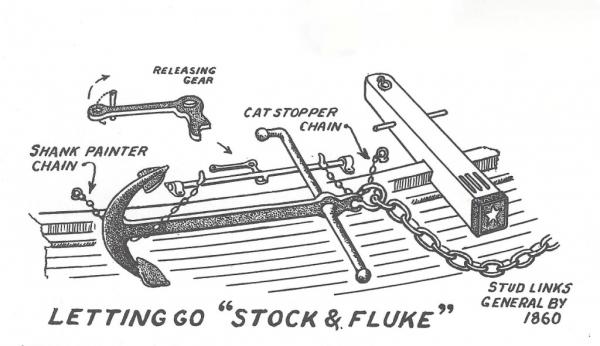-
Posts
9,471 -
Joined
-
Last visited
Content Type
Profiles
Forums
Gallery
Events
Everything posted by Jim Lad
-
Perseverance pays off! Nicely done, Bob! John
- 420 replies
-
YES!! Progress!! Kats, Question 1: If the boats were stowed under the davits, it was common to simply drop the coil of the fall into the boat. If the boats were stowed elsewhere, then it was usual to turn the davits fore and aft and cross the falls, hooking the lower blocks onto the opposite davit. In this case, the falls would be coiled up on the cleat where they were secured. Question 2: If the anchors were stowed for sea, the cables would be unshackled and brought inboard and the anchors stowed on the forecastle. If ready for letting go, then they were either hung off the cathead with a slip or hung off 'stock and fluke' as in the drawing below. I would think a ship such as the Cutty Sark would let go 'stock and fluke'. John
- 237 replies
-
- cutty sark
- revell
-
(and 2 more)
Tagged with:
-
Every little bit you manage is a delight to see, Toni! John
- 1,449 replies
-

Plated Iron Hull
Jim Lad replied to Pete Jaquith's topic in Building, Framing, Planking and plating a ships hull and deck
Pete, It should work well providing it's thin enough for scale. Remember that you tug's hull plates would probably only have been 1/4 or 3/8 inch thick. John -
Well done, Ollie! By the time your internet is fully operational again I suppose that boat will be finished! John
- 803 replies
-
- colonial cutter
- modellers shipyard
-
(and 1 more)
Tagged with:
-
Pretty much ready to rock and roll, Kats! John
- 237 replies
-
- cutty sark
- revell
-
(and 2 more)
Tagged with:
-
Delightful blacksmithing, Augie. She's looking 'top drawer.' John
- 2,191 replies
-
- confederacy
- Model Shipways
-
(and 1 more)
Tagged with:
-

SS Vinal Haven by TBlack - FINISHED
Jim Lad replied to TBlack's topic in - Build logs for subjects built 1851 - 1900
Nearly there, Tom. She's looking great! John- 326 replies
-
- vinal haven
- steam ship
-
(and 1 more)
Tagged with:
-
Just catching up, Remco - she's looking absolutely first class John
- 1,214 replies
-
- sloop
- kingfisher
-
(and 1 more)
Tagged with:
-
Good to see that you have a converted (and convertible) workspace getting close to go, Kats! John
- 237 replies
-
- cutty sark
- revell
-
(and 2 more)
Tagged with:
About us
Modelshipworld - Advancing Ship Modeling through Research
SSL Secured
Your security is important for us so this Website is SSL-Secured
NRG Mailing Address
Nautical Research Guild
237 South Lincoln Street
Westmont IL, 60559-1917
Model Ship World ® and the MSW logo are Registered Trademarks, and belong to the Nautical Research Guild (United States Patent and Trademark Office: No. 6,929,264 & No. 6,929,274, registered Dec. 20, 2022)
Helpful Links
About the NRG
If you enjoy building ship models that are historically accurate as well as beautiful, then The Nautical Research Guild (NRG) is just right for you.
The Guild is a non-profit educational organization whose mission is to “Advance Ship Modeling Through Research”. We provide support to our members in their efforts to raise the quality of their model ships.
The Nautical Research Guild has published our world-renowned quarterly magazine, The Nautical Research Journal, since 1955. The pages of the Journal are full of articles by accomplished ship modelers who show you how they create those exquisite details on their models, and by maritime historians who show you the correct details to build. The Journal is available in both print and digital editions. Go to the NRG web site (www.thenrg.org) to download a complimentary digital copy of the Journal. The NRG also publishes plan sets, books and compilations of back issues of the Journal and the former Ships in Scale and Model Ship Builder magazines.



